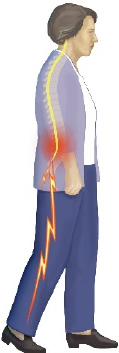Spinal Stenosis Symptoms

If you suffer from lumbar spinal stenosis you may feel various symptoms, including:
- dull or aching back pain spreading to your legs
- numbness and “pins and needles” in your legs, calves or buttocks
- weakness, or a loss of balance, and
- a decreased endurance for physical activities
 Symptoms increase after walking a certain distance or standing for a time. Symptoms can improve when you: Symptoms increase after walking a certain distance or standing for a time. Symptoms can improve when you:
- sit
- bend or lean forward (see Figure below)
- lie down, or
- put your foot on a raised rest
Diagnosing Lumbar Spinal Stenosis
Before confirming a diagnosis of stenosis, it is
important for your doctor to rule out other conditions that may produce similar symptoms.
In order to do this, most doctors use a combination of techniques, including:
- History - Your doctor will begin by asking you to describe any symptoms you have and how the symptoms have changed over time. Your doctor
will also need to know how you have been treating these symptoms, including medications you have tried.
- Physical Examination - Your doctor will then examine you and check for any limitations of movement in your spine, problems with balance, and
signs of pain. Your doctor will also look for any loss of reflexes, muscle weakness, sensory loss, or abnormal reflexes.
- Tests - After examining you, your doctor may use a variety of tests to confirm the diagnosis. Examples of these tests include:
- X-ray - shows the structure of the vertebrae and the outlines of joints.
- MRI (Magnetic Resonance Imaging) - provides a three-dimensional view of our back and can show the spinal cord, nerve roots, and
surrounding spaces, as well as signs of degeneration, tumors or infection.
- CAT Scan (Computerized Axial Tomography) - depicts the three-dimensional shape and size of your spinal canal and bony structures
surrounding it.
- Myelogram - highlights the spinal cord and nerves after a dye is injected into your spinal column, which appears white on an X-ray film
Precaution: Radiological evidence of stenosis must be correlated with your symptoms before the diagnosis can be confirmed.
Treatment Options
Once a diagnosis of spinal stenosis is confirmed, the process of treating the condition usually begins with a regimen of non-invasive, “conservative” therapy.
Non-surgical Treatment of Stenosis
There are a number of ways a doctor can treat stenosis without surgery, including:
- Medications, such as non-steroidal anti-inflammatory drugs (NSAIDs) to reduce swelling and pain, and analgesics to relieve pain.
- Corticosteroid injections (epidural steroids) to reduce swelling and treat acute pain that radiates to the hips or down the leg. Pain relief
from an epidural injection may be temporary and patients are usually advised to get no more than 3 injections per 6-month period.
- Rest or restricted activity.
- Physical therapy and/or exercises to help stabilize the spine, build endurance and increase flexibility.
While some patients obtain relief from symptoms with these treatments, others do not.
©2005 St. Francis Medical Technologies, Inc.
|



 Symptoms increase after walking a certain distance or standing for a time. Symptoms can improve when you:
Symptoms increase after walking a certain distance or standing for a time. Symptoms can improve when you: